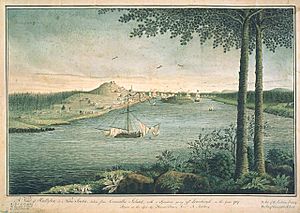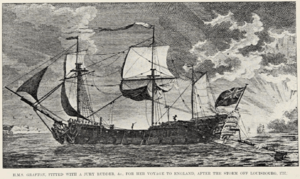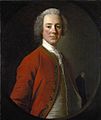Louisbourg Expedition (1757) facts for kids

The Louisbourg Expedition (1757) was a plan by the British to capture a very important French fort called Fortress of Louisbourg. This fort was located on an island then known as Île Royale, which is now called Cape Breton Island. This event happened during the Seven Years' War, which Americans often call the French and Indian War. The British attempt in 1757 did not succeed.
Contents
Why the British Wanted Louisbourg
The French and Indian War began in 1754. It was a fight over land between the French and British colonies in North America. This land is now parts of Pennsylvania and New York. The first few years of the war were tough for the British.
For example, a big trip led by General Edward Braddock in 1755 ended badly. British military leaders could not even plan any major attacks the next year. A big problem for the British happened in August 1756. A French and Native American army, led by General Louis-Joseph de Montcalm, captured Fort Oswego. They also destroyed its defenses. In July 1756, Lord Loudoun arrived to take charge of the British forces in North America. He replaced William Shirley.
British Plans for 1757
Lord Loudoun sent his plan for the 1757 war to London in September 1756. He wanted to attack the main French city of Quebec City. His plan was to only defend the border areas, like the Hudson River and Lake Champlain. These areas were between Albany, New York and Montreal.
Loudoun's plan needed his army to reach Quebec on time. This would stop French soldiers from attacking other places. Instead, the French would have to defend their main area along the Saint Lawrence River. However, there were political problems in London about the war. This led to a change in power. William Pitt the Elder took control of military matters.
Because of this, Loudoun did not hear back about his plan until March 1757. Before that, he made plans for the Quebec trip. He also worked with the governors of the Thirteen Colonies. They planned how to defend the border together.
When William Pitt's orders finally reached Loudoun in March 1757, they had changed. The new plan was to attack Louisbourg first. Louisbourg was on the Atlantic coast of Île Royale. Loudoun was to lead the soldiers on land. A group of warships, led by Francis Holburne, would carry the troops and fight any French ships.
French Get Ready for Battle
French military leaders found out early that the British were planning an attack. They also learned that Louisbourg would be the target. Between January and April 1757, French warship groups sailed from Brest and Toulon. Some of these ships went to make the Louisbourg fleet stronger.
Dubois de La Motte led a group of nine large warships and two smaller ones at Louisbourg. He was joined by Joseph de Bauffremont from Saint-Domingue with five large warships and one smaller one. Four more large ships and two smaller ones came from Toulon under Joseph-François de Noble Du Revest. This meant the French had a very strong navy at Louisbourg.
The Storm at Sea
Admiral Holburne knew that the French had received more ships. But the British expedition was not ready yet. They only sailed in early August. By the middle of August, Holburne's ships were watching Louisbourg. However, Dubois de La Motte chose to keep his ships safe inside the harbor. As the days passed, the weather got worse.
On September 24, 1757, a strong storm scattered the British fleet. The French could not chase them because many of their sailors were sick with typhus. Dubois de La Motte returned to Brest with his sick men on October 30, 1757. The British attack on Louisbourg had failed.
What Happened Next
The British did manage to capture Louisbourg the next year, in 1758.
The delays in Loudoun's orders and the change to attack Louisbourg instead of Quebec had big effects on the war. Because Quebec was not attacked, the French leaders could use their soldiers to fight against Fort William Henry. These soldiers would have been needed to defend Quebec otherwise. Loudoun had left Fort William Henry with very few defenders to staff his expedition.
In August 1757, General Louis-Joseph de Montcalm led 8,000 soldiers, including 1,800 Native Americans, against the British fort. The British gave up after a short siege. After the British surrendered, the French-allied Native Americans attacked the British soldiers as they left. They took many prisoners and harmed some of the wounded soldiers. This event was one of the most talked-about parts of the war.
Images for kids






